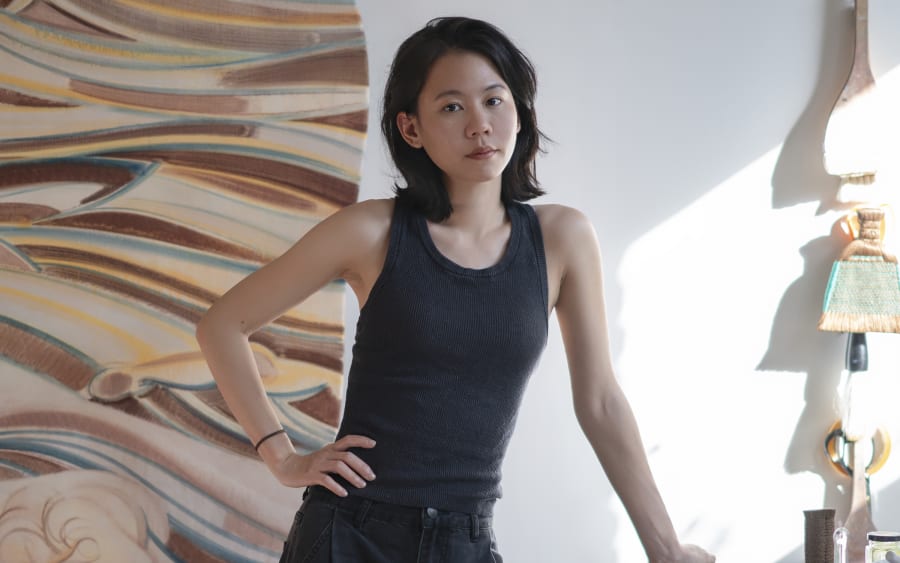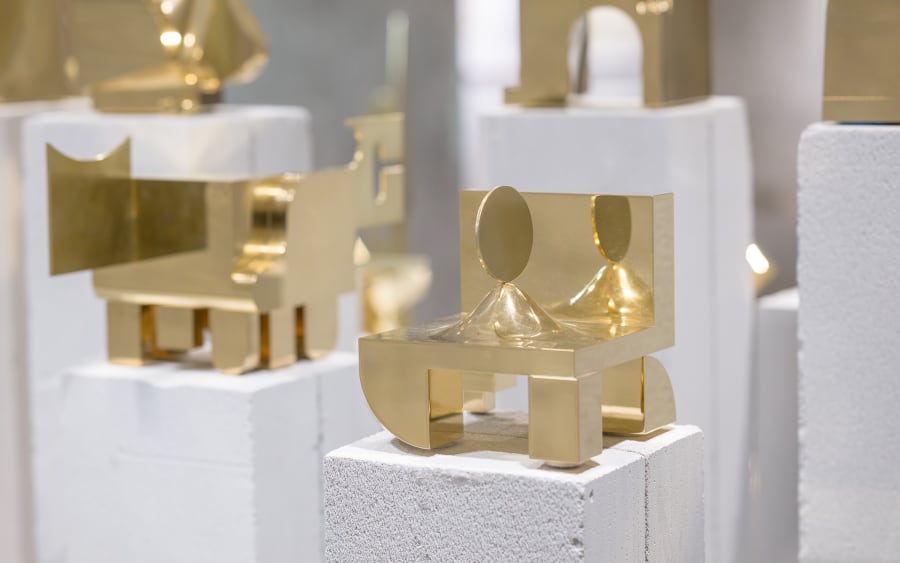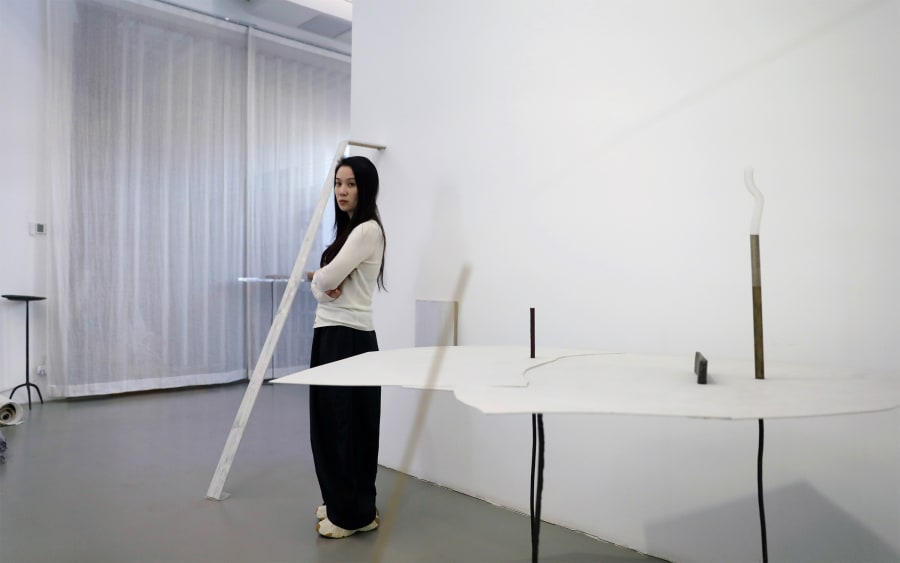This year, Art Basel Hong Kong will welcome a clutch of dynamic Indian galleries, presenting work by artists from South Asia and its diaspora. These mature and sanguine global citizens – whether Indian, Pakistani, or Sri Lankan-French – use their creative energy to build narratives through mixed media, painting, and more. In their work, they tackle migration and displacement, personal and regional histories, the loss of homeland, and the existential quest of finding oneself. Read on to discover five essential voices connected to the region.
Saju Kunhan (b. 1983, India, lives and works in Mumbai)
In a lull during the pandemic, with time on his hands, Saju Kunhan visited his ancestral home in North Kerala, taking a deep dive into the concept of family and what we associate with it. In Hong Kong, six radiant new works, presented by Tarq (Mumbai) and made by manipulating images from his family albums, will illustrate his exploration of the topic. Departing from Kunhan’s earlier use of maps and images sourced from museums, each work involves taking a black-and-white image, enlarging it on recycled teak inlaid with a brass grid, and then filling it with color. This use of vivid hues is a first for him. The omissions, alterations, and juxtapositions in these works aim to spotlight the histories that, without our volition, shape a family’s destiny. Kunhan’s series explores the multiple migrations of his own people and the direct impact colonialism had on them – something that connects a lot of families in India and indeed, the world. Kunhan is also a nominee for the inaugural MGM Discoveries Art Prize, which aims to support emerging artists and foster new talent.
Zaam Arif (b.1999, Pakistan, lives and works in Houston)
Zaam Arif started out as a physics student and flitted between various professions before finding his vocation as an artist – just like his parents. Deeply sensitive and well read, he was raised in an art fraternity in Pakistan: On the Indian subcontinent, artists were often marginalized and built large close-knit communities that blended family and friends, in which children even addressed their parents’ peers as uncles and aunts. It is therefore striking that Arif has made solitude a central tenet of his practice; languid figures feature in large-format paintings with muted brown-blue palettes. In recent works, Arif shows a lone male figure, a leitmotif of sorts that he explains as a ‘need for solitude.’ Similarly, water is a recurring presence. Arif firmly believes that comfort in one’s solitude makes one stronger and that everyone should practice being alone. The resulting peace is what the artist wants his viewer to experience – to go back to a quiet space in their mind or heart and experience stillness.
Sangita Maity (b. 1989, India, lives and works in Kolkata)
Based in the bustling city of Kolkata, Sangita Maity has been working with the Indigenous peoples of the Chota Nagpur Plateau for years. A culturally rich land blessed with extensive mineral resources, the region has been subjected to extensive changes: Mining has turned its hills desolate, while local communities were forcibly displaced. These dramatic changes have fueled Maity’s art. In Hong Kong, Shrine Empire (New Delhi) will present five new paintings by the artist and a series of terracotta sculptures made with the region’s soil and minerals. To make the works, Maity photographed the Chota Nagpur Plateau’s bleak landscape and its tribal people, referring to the images while working. Her practice aims to not only document, but also pay homage to the land and people of the region, burdened by corporate greed and all-encompassing precariousness.
Harminder Judge (b. 1982, United Kingdom, lives and works in London)
When working with plaster, Harminder Judge works swiftly and with focus, or as he puts it, with ‘moments of frenetic energy and moments of waiting.’ Using a unique plaster, polymer, and pigment mix, his works hover in the nebulous zone between sculpture and painting. Judge calls them ‘portals’ to draw the viewer in, admitting that there is also performative element to the making of his art, something he ascribes to a previous career as a performance artist. All of Judge’s works are titled with words associated with his grandfather’s funeral in Punjab, which the artist attended as a teenager and had a searing effect on his mind. It is not surprising then that his abstract works, which will be presented at Art Basel Hong Kong by Jhaveri Contemporary (Mumbai), have a metaphysical quality.
Vasantha Yogananthan (b.1985, France, lives and works in Marseille)
‘Color itself is a kind of ever-open question for me’ says Vasantha Yogananthan, a photographer of French-Sri Lankan parentage. His eye-catching, hand-colored black-and-white C-prints evoke the nostalgia of primitive photography and explore the liminal space bridging the past and present. A serendipitous meeting between Yogananthan and Indian painter Jaykumar Shankar led to a collaboration that still endures. Yogananthan sends Shankar black-and-white prints, which Shankar then tints by hand with carte blanche. Using Magic Fishes, Kanyakumari, Tamil Nadu, India, 2013
(2013) as an example, he explains: ‘When I took this still life of fishes drying in the sun in a small village of Tamil Nadu, I knew Jaykumar would do something that would be closer to magical realism, and he did exactly that. He made the dead fish on the concrete alive, like they were swimming.’ Together, they bring to life a singular work of art and continue a unique tradition.
Saju Kunhan is represented by Tarq (Mumbai), who'll dedicate a solo presentation to the artist in Art Basel Hong Kong's Discoveries sector.
Zaam Arif is represented by Vadehra Art Gallery (New Delhi), who will show work by the artist in Art Basel Hong Kong's Galleries sector.
Sangita Maity is represented by Shrine Empire (New Delhi), who'll dedicate a solo presentation to the artist at Art Basel Hong Kong's Insights sector.
Harminder Judge and Vasantha Yogananthan are represented by Jhaveri Contemporary (Mumbai).
Deepthi Sasidharan is an art historian, curator, and Founder Director at Eka Archiving, a cultural advisory specializing in heritage and museum projects across the Indian subcontinent and Middle East. She also teaches, lectures, and writes across various platforms.
Top image: Zaam Arif, Waking Dream, 2024. Courtesy of Vadehra Art Gallery.
Published on February 4, 2025.


